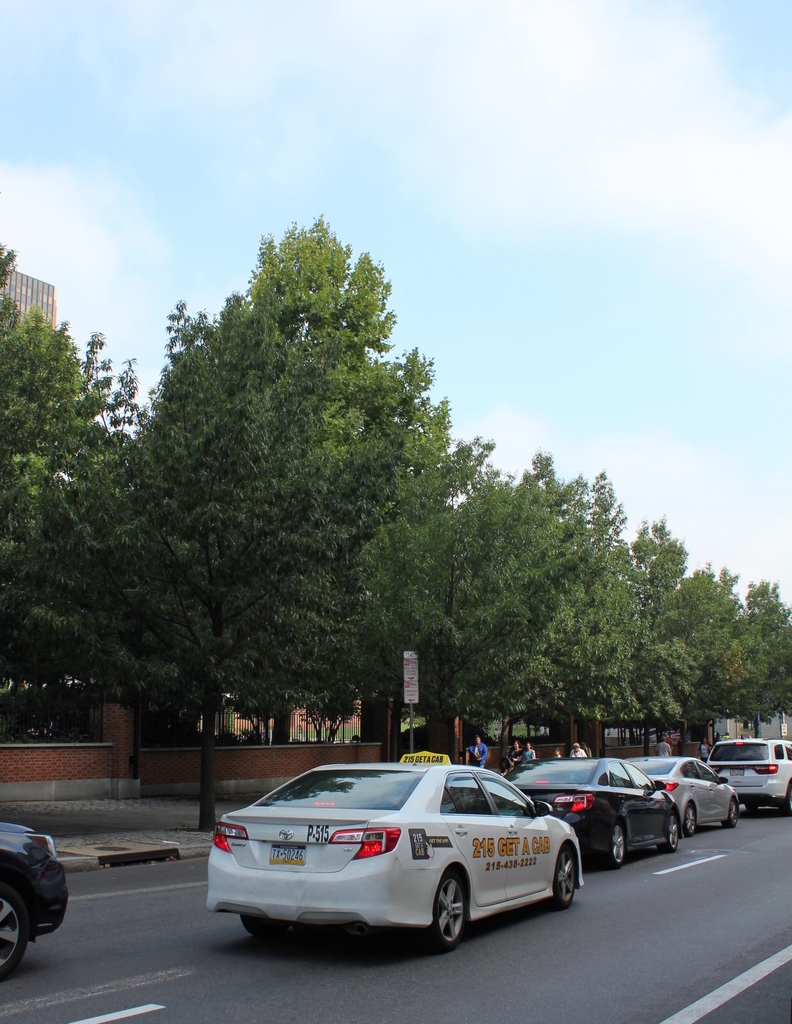Looking west on Chestnut Street between Bank and Third Streets in Philadelphia, around 1859. Image courtesy of the Library Company of Philadelphia, Frederick De Bourg Richards Photograph Collection.

The scene in 2019:

The first photo shows the view looking west along the south side of Chestnut Street, from near the corner of Bank Street. The scene features a variety of commercial buildings, but the most prominent of these is the Jayne Building in the center of the photo. Built between 1849 and 1851, this eight-story building was far ahead of its time, predating the advent of modern skyscrapers by nearly half a century. As such, it is generally considered to be the first skyscraper in the city, and arguably the first in the entire country as well.
The Jayne Building was designed by local architect William L. Johnston, and it featured a Gothic Revival exterior of Quincy granite. In contrast to most of the neighboring buildings, its façade featured strong vertical lines that emphasized its height, a technique that would later become common for 20th century skyscrapers. However, the building also featured a two-story crenelated tower atop the roof, giving it an unusual combination of modern and medieval-style architecture.
The building was owned by Dr. David Jayne, a physician who made his fortune selling patent medicines. Although based in Philadelphia, he sold his products across the country. He even published a free almanac that was replete with medical advice, most of which involved taking one or more of his products. Among these were the Expectorant, which was intended for lung diseases, and the Alterative, which Jayne claimed could treat a wide range of ailments, including cancer, gout, rheumatism, scrofula, scurvy, syphilis, ulcers, and various skin disorders.
Architect William L. Johnston provided much of the vision for Jayne’s building, but he did not live to see it completed. He died of tuberculosis during the early stages of the construction, and another Philadelphia architect, Thomas Ustick Walter, oversaw the rest of the work. Walter also designed two six-story wings, one on either side of the main building, which were completed in 1851 and are visible here in the first photo. Also in 1851, Walter was appointed as Architect of the Capitol, and in this capacity he designed both the House and Senate wings of the US Capitol, along with the current Capitol dome.
David Jayne died in 1866 at the age of 66, but his family carried on the business for many years. However, just six years later this building was gutted by a massive fire on the night of March 4, 1872. The fire started around 9:00 p.m. in the rear of the third floor, but it soon spread up to the top of the building. Firefighting efforts were hampered by the height of the building, and also by the sub-zero temperatures, which caused the water to freeze into icicles on the exterior. However, firefighters succeeded in preventing the flames from spreading to the six-story wings, and most of the exterior walls remained standing, despite extensive damage to the interior.
The building was subsequently reconstructed around the old walls, albeit without the ornate two-story tower atop the roof. It would remain here for the next 80 years, but by the mid-20th century it was threatened by an urban renewal project related to the Independence National Historical Park. Planners envisioned a park area that would feature the city’s prominent Revolutionary-era landmarks surrounded by open space, rather than being crowded by more recent development. This meant the demolition of many 19th century buildings that, despite their architectural and historic significance, were not a part of the park’s mission.
In the case of the Jayne Building, it stood on the periphery of the park, three blocks away from Independence Hall. The mid-19th century proto-skyscraper clearly had no connection to the American Revolution, but some preservationists made an effort to have the building spared. Among these was Charles E. Peterson, who in 1951 published a theory that the Jayne Building had likely helped to influence the design of more modern skyscrapers, since prominent architect Louis Sullivan had once worked out of an office across the street from here. However, this appeal failed to convince the park planners to save the building, and it was ultimately demolished in the fall of 1957.
Today, more than 160 years after the first photo was taken, there are no surviving landmarks from the first photo. Many of the older commercial buildings were likely replaced by newer buildings later in the 19th century, but anything that was still standing by the 1950s would have, like the Jayne Building, been demolished as part of the Independence National Historical Park. Here in the foreground, where the Jayne Building once stood, this site became a visitors center. This building was, in turn, demolished in 2014, and the site is currently occupied by the Museum of the American Revolution, which is shown here in the 2019 photo.












